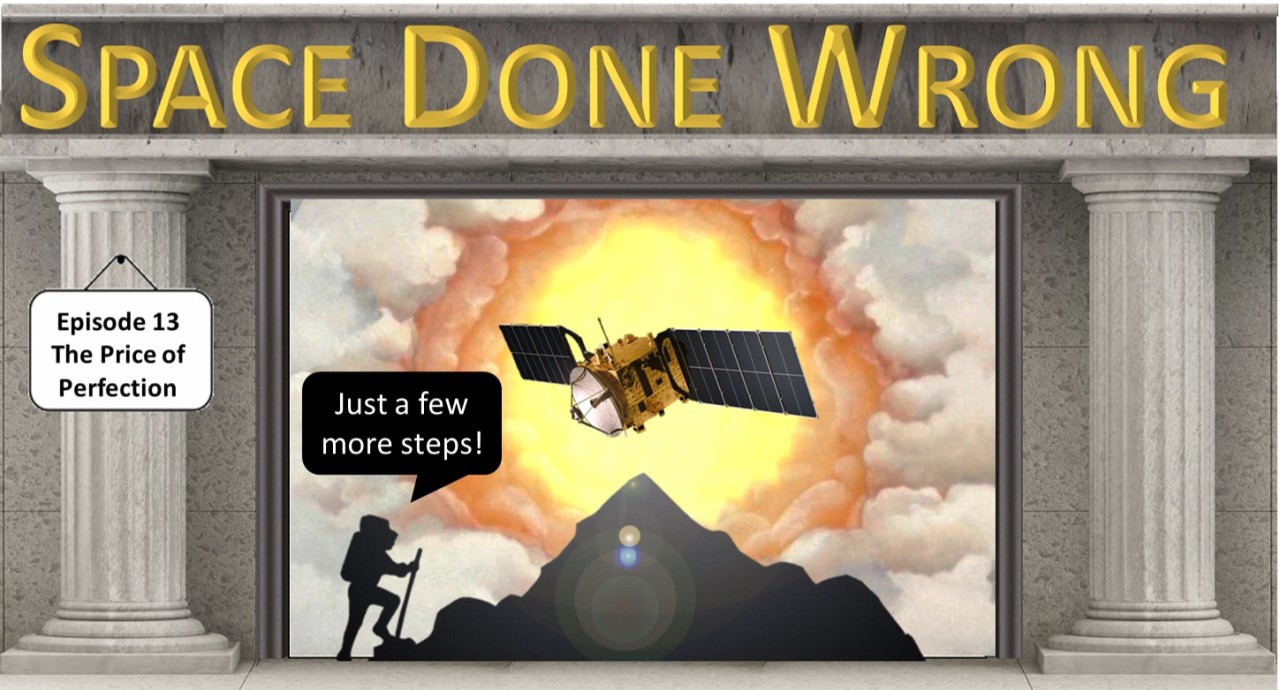Germany prides itself to have some of the best satellites in the world. However in a very German strife for perfection we often wait more than a decade until they become available. I would argue, that for those who wait for that capacity – good enough today is better than perfect tomorrow. Unfortunately, since it is not likely that we will start building anything less than perfect in major government missions, I am going to advocate that in addition to our flagships we need capacity now. In this article I will address why this is the case and what could be done. Let’s have a look!
Introduction
I read in the news [1] that, according to the German government, the high resolution optical satellite system (GEORG) is delayed by “several” years past its planned delivery date in 2022. This reminded me that in 2017 when this project was first written about in public newspapers I was joking among my close friends that I would bet them a beer that before 2027 we won’t see the GEORG satellites in Orbit.
Why is it that the delay of the latest German flagship satellite does not surprise me?
The reason why I was able to lightheartedly but confidently make such a assessment is that this is the ground reality of German state of the art satellite systems. We want too much and we want it with so much perfection that everything else looks like an afterthought. If in result we wait, only “several years” and not a whole decade we are actually lucky. Why this is bad for everyone involved we will learn in this article.
The cost of being perfect
I am German, therefore I love perfect solutions, too (at least that is what my wife tells me). We should however remind ourselves that we started out the quest to get something because we had a pressing need. So while we are working on implementing that perfect solution the need will still persist. In addition a need is rarely black and white, that means if a solution is not perfect it still is useful to some degree. What ever that degree is, it is better than nothing.
The solution that you have is better than the one that you don’t.
In Germany we even have an Idiom for that: “der Spatz in der Hand ist besser als die Taube auf dem Dach” (the sparrow that you have (in your hand) is better than the dove which you don’t (on the roof). Unfortunately when it comes to space missions we tend to forget all about it and want nothing but perfection. This in the end leads to us not getting anything, at least for a very long time.
Schedule delays
The first thing that usually happens is that somebody along the line was too optimistic in their ability to solve certain problems. At some point each project will run into problems, it could be that the new SiC structure is breaking during environmental tests, the unavailability of your next generation image sensor or simply the piling of cursed overheads.

Cost Overruns
In addition one needs to consider as delays are rarely cost neutral. What that means is that while you are waiting for one delayed component to arrive the rest of the team will very likely find other tasks to further increase the perfection of the device. As a result a 25% delay usually directly translates into a 25% cost increase.
Delays are rarely cost neutral.
Once one part of the program is delayed some other parts will ask for more love, too
Or as explained in Episode 01 of the series – Innovation does not pay – space projects rarely have true firm fixed price contracts there is in fact incentive on the supplier side trying to up-sell via a host of contract change notices or CCN’s.

I mean why not, your are already building the perfect space device you better make it right and when somebody is coming up with a great idea what new feature to while you wait for somebody else, that can’t be bad.
If you ask for cutting edge it may be you who is bleeding in the end
The cause for decade long delays and cost overruns therefore come in tandem: too high specification in the beginning will meet a supplier who will put a quotation and schedule which is too optimistic because hey if all goes south we can do CCN’s anyway. At the end of this tango it is mostly the tax payer who is bleeding from the cutting edge technology.
Secondary Effects
The quest for the one giant leap has various side effects which can be equally hurting than getting something late and at a heinous price, we will look at this next
No science, No commercial application, No security
Imagine you are a researcher at the GFZ Potsdam, like Prof. Kaufmann who until his retirement in 2014 was the principal investigator (PI) of EnMAP, then not only did you retire [2] but also your successor as PI looked for a greener pasture after 5 years [3] and that your second successor also is already waiting 3-4 years before she will be able to see the satellite produce the first science data. Not only are hundreds of science papers unwritten due to lack of raw data in addition, the commercial application of hyper spectral data will likely happen somewhere else as we are still stuck in the prototype phase.
While you wait for your perfect space program, you often have nothing

In case you will argue that some science takes time and no compromise can be made I would like to point out that there are cases in which, too late can have grave consequences. I am not primarily talking about detecting the cause and effect of the climate catastrophe 10 years later but cold and hard security implications. In the case on Heinrich Hertz, the combined GEO Comsat for the defence and IOD satellite for the industry, there won’t be secure communication without involving 3rd party and in case of GEORG, Germany continues to be without own high resolution optical system which means that we are further reliant on the goodwill of our allies and commercial suppliers.
Slow Progress, Fewer Innovation
If the time to design a satellite system is 10 years or more then any one engineer will only see 2-3 projects in its entire career. This does not make for a very exciting work place if to see results you have to wait half your professional career. The argument is often that it takes time to reach the pinnacle of performance. That said, common sense has it that practice makes the master. Most companies that are hallmarks of innovation pride themselves in rapid innovation. I therefore wager that without steady repetitions, without learning from mistakes and gradual improvements your chance to actually reach perfection is slim.

You should also consider that a project that continues to consume financial resources and workforce will block a nation from achieving greatness in other projects. If you ask anyone in Germany who has proposed new projects about what they got as reasons for the rejection, there is a very high likelihood that the finger were pointed towards the long overdue projects EnMAP or Heinrich Hertz. If you want an actual example for an innovative project that did not receive funding despite its innovation potential, look no further than DEOS, the in orbit servicing mission of DLR that was axed after the initial feasibility study.
DEOS was innovative, it had however the problem that it needed money in the years where EnMAP and Heinrich Hertz already ate all available resources
Considering the problem that we have with space debris this project could have provided valuable lessons how to de-orbit large spacecrafts such as EnviSat. DEOS could have further been a stepping stone for orbital servicing assembly and manufacturing (OSAM) which many believe to be one of the key space markets in the future.
Not Sustainable
Another important point to consider is that the more complex a system is, the longer the lead time and planned system life, the less will your development teams be able to recoup some of the technology investments of prior generations. In fact it is very likely that you will have to build everything from scratch. Not only are non of the electronic components available anymore so are your people who have built the system. This is hardly cost effective. Instead of building on things prior you always start from scratch which will trap you further in a spiral of long projects, with slow progress, high cost and low innovation.
What can be done different
First of all we need a different mindset in space, not only in German missions but as my recent articles have shown perfectionism and the fear of failure is a common ill across many great stakeholders in space. What I would like to advocate is that we learn from the success of those who push the envelope such as SpaceX and Planet. Fast iterations, with less than perfect intermediary steps, acceptance of potential failures and acceptance of a good enough capacity.
We need to establish in the space industry targets that are good enough.
We need to reach these goals fast and at minimum expenditure
As we will likely not start replacing flagships why not set aside a hedging bet?
At the very least if building perfect is the only acceptable term, why don’t we set aside 10-20% of each budget to achieve some form of good enough capacity fast?
What comes next?
In contrast to other episodes where I get inspired by a topic and then write the bonus articles, I started this month already with a collection of four perfect space systems which I wanted to look at. These four I would have normally put into one article. However, while I was doing research I found that there would likely be too much ground to cover for one article. I have thus split and will deliver the four case studies as bonus articles.
- Case Study EnMAP – 10 year mission delay
- Case Study GEORG – bleeding edge
- Case Study Heinrich Hertz – World Wide Wait
- Case Study DEOS – Cancelled
How can you help:
This text is part of a series of articles in which the author sets the framework to start a discussion about the wrongs of the space industry. If you have experienced similar things, leave a comment. Other views and opinions are very welcome, too, as they may present a way forward. Please be kind to each other.
Disclaimer
The author’s views are his own do not represent the views of his company Berlin Space Technologies.
Sources
[1] GEORG delayed by several years – T Online news – 31.10.2021
[2] GFZ News Prof. Kaufmann retires as EnMAP principal investigator in 2014 his successor is Prof. Luis Guanter
[3] GFZ News Prof. Luis Guanter is succeeded by Sabine Chabrillat in 2019


Leave a Reply